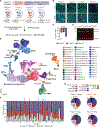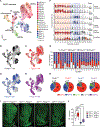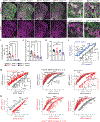Single-Cell Analysis of Foxp1-Driven Mechanisms Essential for Striatal Development
- PMID: 32130906
- PMCID: PMC7137930
- DOI: 10.1016/j.celrep.2020.02.030
Single-Cell Analysis of Foxp1-Driven Mechanisms Essential for Striatal Development
Abstract
The striatum is a critical forebrain structure integrating cognitive, sensory, and motor information from diverse brain regions into meaningful behavioral output. However, the transcriptional mechanisms underlying striatal development at single-cell resolution remain unknown. Using single-cell RNA sequencing (RNA-seq), we examine the cellular diversity of the early postnatal striatum and show that Foxp1, a transcription factor strongly linked to autism and intellectual disability, regulates the cellular composition, neurochemical architecture, and connectivity of the striatum in a cell-type-dependent fashion. We also identify Foxp1-regulated target genes within distinct cell types and connect these molecular changes to functional and behavioral deficits relevant to phenotypes described in patients with FOXP1 loss-of-function mutations. Using this approach, we could also examine the non-cell-autonomous effects produced by disrupting one cell type and the molecular compensation that occurs in other populations. These data reveal the cell-type-specific transcriptional mechanisms regulated by Foxp1 that underlie distinct features of striatal circuitry.
Keywords: FOXP1; autism; neurodevelopment; single-cell RNA sequencing; striatum.
Copyright © 2020 The Author(s). Published by Elsevier Inc. All rights reserved.
Conflict of interest statement
Declaration of Interests The authors declare no competing interests.
Figures







Similar articles
-
FOXP1 negatively regulates intrinsic excitability in D2 striatal projection neurons by promoting inwardly rectifying and leak potassium currents.Mol Psychiatry. 2021 Jun;26(6):1761-1774. doi: 10.1038/s41380-020-00995-x. Epub 2021 Jan 5. Mol Psychiatry. 2021. PMID: 33402705 Free PMC article.
-
Reduced Expression of Foxp1 as a Contributing Factor in Huntington's Disease.J Neurosci. 2017 Jul 5;37(27):6575-6587. doi: 10.1523/JNEUROSCI.3612-16.2017. Epub 2017 May 26. J Neurosci. 2017. PMID: 28550168 Free PMC article.
-
FoxP1 orchestration of ASD-relevant signaling pathways in the striatum.Genes Dev. 2015 Oct 15;29(20):2081-96. doi: 10.1101/gad.267989.115. Genes Dev. 2015. PMID: 26494785 Free PMC article.
-
FOXP1 syndrome: a review of the literature and practice parameters for medical assessment and monitoring.J Neurodev Disord. 2021 Apr 23;13(1):18. doi: 10.1186/s11689-021-09358-1. J Neurodev Disord. 2021. PMID: 33892622 Free PMC article. Review.
-
FOXP1: a potential therapeutic target in cancer.Expert Opin Ther Targets. 2007 Jul;11(7):955-65. doi: 10.1517/14728222.11.7.955. Expert Opin Ther Targets. 2007. PMID: 17614763 Free PMC article. Review.
Cited by
-
A Cellular Resolution Spatial Transcriptomic Landscape of the Medial Structures in Postnatal Mouse Brain.Front Cell Dev Biol. 2022 May 17;10:878346. doi: 10.3389/fcell.2022.878346. eCollection 2022. Front Cell Dev Biol. 2022. PMID: 35656552 Free PMC article. No abstract available.
-
Expression of FoxP2 in the basal ganglia regulates vocal motor sequences in the adult songbird.Nat Commun. 2021 May 11;12(1):2617. doi: 10.1038/s41467-021-22918-2. Nat Commun. 2021. PMID: 33976169 Free PMC article.
-
Striatal Control of Movement: A Role for New Neuronal (Sub-) Populations?Front Hum Neurosci. 2021 Jul 20;15:697284. doi: 10.3389/fnhum.2021.697284. eCollection 2021. Front Hum Neurosci. 2021. PMID: 34354577 Free PMC article. Review.
-
Increased locomotor activity via regulation of GABAergic signalling in foxp2 mutant zebrafish-implications for neurodevelopmental disorders.Transl Psychiatry. 2021 Oct 14;11(1):529. doi: 10.1038/s41398-021-01651-w. Transl Psychiatry. 2021. PMID: 34650032 Free PMC article.
-
A MYT1L syndrome mouse model recapitulates patient phenotypes and reveals altered brain development due to disrupted neuronal maturation.Neuron. 2021 Dec 1;109(23):3775-3792.e14. doi: 10.1016/j.neuron.2021.09.009. Epub 2021 Oct 5. Neuron. 2021. PMID: 34614421 Free PMC article.
References
-
- Anderson SA, Qiu M, Bulfone A, Eisenstat DD, Meneses J, Pedersen R, and Rubenstein JL (1997). Mutations of the homeobox genes Dlx-1 and Dlx-2 disrupt the striatal subventricular zone and differentiation of late born striatal neurons. Neuron 19, 27–37. - PubMed
-
- Andrews S (2010). FastQC: a quality control tool for high throughput sequence data. https://www.bioinformatics.babraham.ac.uk/projects/fastqc/.
Publication types
MeSH terms
Substances
Grants and funding
LinkOut - more resources
Full Text Sources
Molecular Biology Databases

